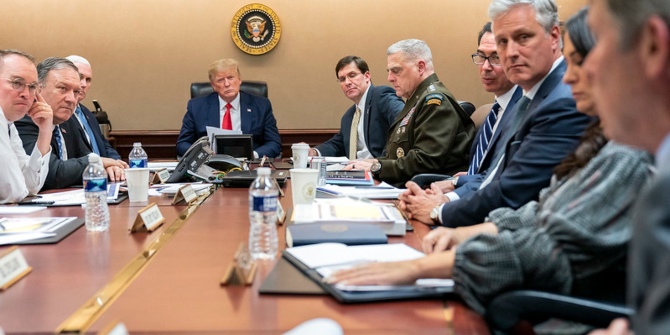 Given that China is a strategic and economic rival to the US, the Trump administration’s framework for US-China trade makes far more sense than one that focuses on economic benefits alone, writes Kevin James.
Given that China is a strategic and economic rival to the US, the Trump administration’s framework for US-China trade makes far more sense than one that focuses on economic benefits alone, writes Kevin James.
In his recent Wilson Center speech, Vice-President Pence argued that US trade policy towards China must now be built upon the premise that China is a “strategic and economic rival”. This change in perspective has naturally led the US to rethink its current trade policy with China, and this rethinking has in turn put the US and China on their current path towards a trade war and economic decoupling. At this crucial juncture, an exceptionally distinguished group of Western and Chinese academics formed the US-China Trade Policy Working Group (TPWG) to devise a policy framework that would prevent this trade war. Yet, the TPWG framework accomplishes this goal only by taking a narrowly economic focus that banishes the strategic perspective that makes the trade war necessary from the discussion. So, while conceiving of US-China trade policy as the TPWG suggests would certainly advance China’s strategic ambitions, doing so would be a disaster for the US. It follows that the Trump administration’s framework for US-China trade is by far the better choice.
The TPWG — led by Dani Rodrik (Harvard), Jeffrey Lehman (NYU Shanghai), and Yang Yao (Peking University), and including senior Chinese academics Jiandong Ju (Tsinghua University) and Justin Yifi Lin (Peking University, former chief economist at the World Bank) — starts from the premise that the objective of a country’s trade policy is to maximise the economic benefits it obtains from its trading relationships subject to domestic political and social constraints (adding the constraints is what distinguishes the TPWG framework from the traditional free trade position). And, to be fair, this framework does indeed provide a useful way of thinking about how the US should approach trade with, for example, Canada or a post-Brexit UK. As a framework for a trading relationship with a hostile strategic and economic rival, however, it suffers from two fundamental flaws.
First, under the narrow “own economic benefit” TPWG framework, the US will not be thinking about how its trade policy affects the US-China balance of power (that is, about the relative benefit that each party obtains from the trading relationship). Again, ignoring balance of power considerations makes sense with a country such as Canada because Canada is not striving to put itself into a position to avenge the loss of the Ohio territory in the French and Indian War. China is not like Canada. China is deliberating amassing power to enable it to act against US interests in Asia and globally. Any rational US trade policy towards China must be designed with this fact at its core (as Earl Thompson’s pioneering work on national defense and policy would suggest).
Second, the TPWG framework seeks to defuse the issues that are now collectively leading to a trade war by disaggregating them. So, under the TPWG framework, the US and China would: i) treat each economic issue individually; ii) delink economic and non-economic issues; and iii) deal with issues that affect both the US and its allies either as series of separate bilateral negotiations or on a multilateral basis that reflects international norms. Under this approach, the US would be so involved in arguing over a myriad of individual trees that it would lack the bandwidth to even conceive of the forest, let alone devise an appropriate response. To deal effectively with China as a strategic rival, the US must look at its trade policy as a unified whole rather than as an ad hoc collection of separate and independent issues.
To illustrate just how dangerous the TPWG framework would be for the US, consider how it would deal with arguably the most important trade issue now before the US and China: Huawei’s drive to install core elements in the new 5G networks of key US allies and a number of other countries. There is now an enormous amount of evidence suggesting that Huawei is effectively an arm of the Chinese state (see, for example, here, here, and here) rather than a private company that just happens to be Chinese (there is a debate about Huawei’s exact corporate structure and the extent of its links to the Chinese government, but, in my opinion, this debate is a bit beside the point as I do not see how there can be such a thing as a private company in a country where the government can harvest your organs if you piss it off). If Huawei is effectively an arm of the Chinese state, then any country that allows Huawei to install core elements of its 5G network will sacrifice network security and will thereby provide China with a significant strategic advantage. So, assuming that Huawei does pose a threat to network security, how should the US deal with it?

Under any rational trade policy, the US would coordinate a joint response with its allies and other affected countries to the collective security threat that Huawei poses. Yet, according TPWG member Jiandong Ju, under the TPWG framework “bilateral confrontation policies would not expand to the rest of the world…big countries, like the US and China [would] limit their confrontational actions to bilateral and not expand to multilateral confrontations”. TGWG member Justin Yifu Lin takes basically the same position, arguing that “A developed country may suppress…leading industries in a developing country [to maintain] its vested status and interests in the name of national security. This kind of behaviour is essentially a bullying behaviour and should be condemned and prohibited”. In short, the TPWG framework makes it far more difficult for the US to devise an effective response to Huawei and other such issues.
So, the TPWG framework would put the US into a position in which it is simply incapable of formulating a strategically coherent trade policy for China. One can see why the Chinese are delighted to have these ideas in play (and the tale of how this came to pass would surely make for a great novel by a future Alan Furst), but it would be absolute lunacy for the US to sign up to them. The Trump Administration’s position provides a far more sensible framework for US-China trade.
- This blog post originally appeared at LSE Business Review
- Note: This article gives the views of the author, and not the position of not the position of the European Bank for Reconstruction and Development, USAPP – American Politics and Policy, nor the London School of Economics.
- Featured image by 玄史生, public domain
Please read our comments policy before commenting
Note: The post gives the views of its authors, not the position USAPP– American Politics and Policy, nor of the London School of Economics.
Shortened URL for this post: http://bit.ly/2RKpqnX
 Kevin R. James – LSE Systemic Risk Centre
Kevin R. James – LSE Systemic Risk Centre
Kevin R. James is an economist in the LSE’s Systemic Risk Centre. His research focuses upon financial market efficiency and effectiveness, systemic risk, corporate finance, and asset management.






